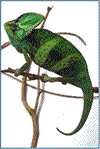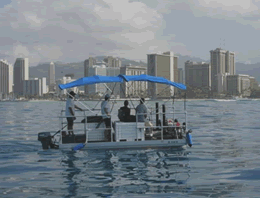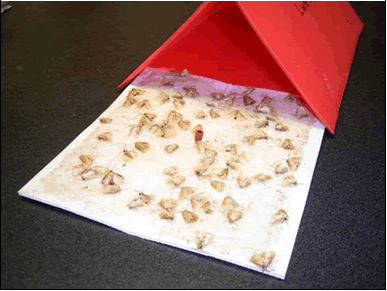FY05 Funded Projects
FY05 (July 1 2004-June 30 2005) was the first year that the HISC disbursed project funding. The HISC disbursed $4M in FY05 to support projects relating to invasive species prevention, control, outreach, and research. A full description of FY05 activities can be found in the 2006 legislative report. Individual project summaries are below.
Prevention
- $990,000 to support 1) increased numbers of and training for quarantine staff; 2) specialists to identify new insects, plants and diseases and 3) technicians/supervisors and needed infrastructure to lead invasive species control efforts on the ground; support to the Department of Health for West Nile Virus programs; USDA – Wildlife Services for a brown tree snake search and risk assessment in cargo leaving Guam; and support for a marine species information and interdiction network.
Control
- $1,200,000 to conduct invasive species detection, response and control actions on the ground. The work of the island Invasive Species Committees on priority pests in each county will be supported along with a pilot marine response program being developed by the Department of Land and Natural Resources – Division of Aquatic resources in cooperation with Federal, private and county resources.
Outreach
- $210,000 to conduct a statewide outreach program in cooperation with the public and private sector for visitors and residents to increase voluntary compliance of quarantine laws, avoid accidental introductions of invasive species, and establishing an effective pest hotline that delivers timely information to managers on the ground.
Research
HISC research and technology evaluation committees completed a review of dozens of proposals. Reviewers included staff and experts from DOA, DEBDT, DOH, DLNR, HISC, USDA, UH, Bishop Museum, USGS etc. Fifteen projects were selected for funding in 2005. More detail is provided below.
[spoiler open=”No” title=”Ecological consequences of the coqui frog invasion into Hawaii” icon=”chevron”]Beard/Utah State University $26,800
Summary: coqui were introduced from Northeastern Puerto Rico. In March 2004, the Mayor of Hilo, Hawaii declared the coqui frog situation a state of emergency. This frog impacts Hawaiian ecosystems, especially native birds and threatens the multi-million dollar floriculture and nursery industries. Its 90-decibal mating call is driving down property prices on the Big Island. To date efforts have focused on eradication, but scientists are now trying to understand its ecological impact. Frogs diets were examined, they eat endemic beetles, mites, springtails and flies as well as a variety of non-native species. Meanwhile there was no evidence that the frogs reduced non-native invertebrate pest populations. Where frogs were abundant leaf litter decomposition and nutrient cycles changed, and invertebrate abundance declined. Frogs were found to be infected with a fungus implicated in the declines of frogs elsewhere, but it appeared to have little effect in terms of controlling frog populations on the Big Island. Abstract. Rats were not found to eat coqui. Despite high coqui abundance mongoose ate few frogs. Cane toads did not eat coqui. Repeated aerial treatments with 11% citric acid were found to effectively control frogs, but reinfestation from untreated areas followed.
Peer-reviewed articles:
Infection of an invasive frog Eleutherodactylus coqui by the chytrid fungus Batrachochytrium dendrobatidis in Hawaii, Beard, KH and O’Neill, EM (2005). Biological Conservation 126: 591-595.
Potential predators of an invasive frog (Eleutherodactylus coqui) in Hawaiian forests, Beard, KH and Pitt, WC (2006). Journal of Tropical Ecology 22:1-3.
Population Density Estimates and Growth Rates of Eleutherodactylus coqui in Hawaii, Beard, KH; Al-Chokhachy, R; Tuttle, NC; O’Neill, EM (2008). Journal of Herpetology 42(4): 626-683.
Diet of the Invasive Frog, Eleutherodactylus coqui, in Hawaii, Bearch, KH (2007). Copeia 2: 281-291.
An invasive frog, Eleutherodactylus coqui, increases new leaf production and leaf litter decomposition rates through nutrient cycling in Hawaii, Sin, H; Beard, KH; and Pitt, WC (2008). Biological Invasions 10: 335-345.
Aerially applied citric acid reduces the density of an invasive frog in Hawaii, USA, Tuttle, NC; Beard, KH; and Al-Chokhachy, R (2008). Wildlife Research 35: 676-683.
Invasive litter, not an invasive insectivore, determines invertebrate communities in Hawaiian forests, Tuttle, NC; Beard, KH; and Pitt, WC (2009). Biological Invasions 11: 845-855.
Dudley/HARC $21,500
Summary: The study had three primary immediate goals: 1) Determine the effectiveness of Japanese beetle traps baited with ethanol as a method for trapping the black twig borer; 2) Determine the effectiveness semiochemicals, verbenone and limonene as repellents for the black twig borer; 3) Compare the effectiveness of Japanese beetle traps versus the more cumbersome Lindgren funnel traps. Ethanol traps were effective trapping more than 11,000 twig borers in four months. Verbenone was the most effective repellent, also repelling two other borer species. The author recommends the use of the Japanese beetle traps not only because they are more effective at catching the twig borer, but also because of their small size, durability and price.
[/su_spoiler] [spoiler open=”No” title=”Detecting the veiled chameleon on Maui: A research proposal to enhance control of an injurious species” icon=”chevron”]Duffy/Maui Invasive Species Committee, $25,000
 Summary:The veiled chameleon (Chamaeleo calyptratus), native to Yemen and Saudi Arabia , is an injurious alien species in Hawaii . State officials believe that the veiled chameleon poses a greater risk to native plants and animals than the well-established Jackson’s chameleon (Chamaeleo jacksonii). The veiled chameleon is larger (up to 2 feet long), is known to tolerate a wider range of environmental conditions in its native range, and is an omnivorous feeder. The intent of this research project is to obtain basic natural history information for the Makawao population to improve detection of veiled chameleons and to test different detection and capture methods to enhance effectiveness of control efforts.
Summary:The veiled chameleon (Chamaeleo calyptratus), native to Yemen and Saudi Arabia , is an injurious alien species in Hawaii . State officials believe that the veiled chameleon poses a greater risk to native plants and animals than the well-established Jackson’s chameleon (Chamaeleo jacksonii). The veiled chameleon is larger (up to 2 feet long), is known to tolerate a wider range of environmental conditions in its native range, and is an omnivorous feeder. The intent of this research project is to obtain basic natural history information for the Makawao population to improve detection of veiled chameleons and to test different detection and capture methods to enhance effectiveness of control efforts.
Durston/Leilani Nursery, $22,675
Summary: Bill Durston successfully developed a facility for treating pallet loads of plants with hot water. This kills frogs found on plants and is an effective means to prevent the movement of coqui frogs from the Big Island in nursery plants. The Department of Agriculture has adopted the technology.
[/su_spoiler] [spoiler open=”No” title=”Pilot multi-agency early detection reporting system” icon=”chevron”]Hopkins/PBIN, $37,000
Summary:A system for community based reporting and data collection was developed. Maui public can be part of the “eyes and ears” team.
[/su_spoiler] [spoiler open=”No” title=”Development of methods to control alien algae on Hawaii’s reefs” icon=”chevron”]Hunter/University of Hawaii, $33,192
 Summary: Hawaiian coral reefs are under attack by invasive alien algae. Dubbed the “Super Sucker” for its giant vacuum action, a mechanical alien algae suction device sits in O’ahu’s Kane’ohe Bay dredging thousands of pounds of seaweed from the reefs off the islet of Moku O Loe. The removed seaweed is then used for compost by local taro farmers. Scientists are also testing a native sea urchin to help control the re-growth of algae after its removal.Gracilaria salicornia and kappaphycus/Eucheuma spp are the target species which have spread widely in the last decade. The control resulted in less seaweed accumulating on nearby beaches and helped some corals to recover. Though the study was carried out Kane’ohe the supersucker has been used elsewhere to good effect since then.
Summary: Hawaiian coral reefs are under attack by invasive alien algae. Dubbed the “Super Sucker” for its giant vacuum action, a mechanical alien algae suction device sits in O’ahu’s Kane’ohe Bay dredging thousands of pounds of seaweed from the reefs off the islet of Moku O Loe. The removed seaweed is then used for compost by local taro farmers. Scientists are also testing a native sea urchin to help control the re-growth of algae after its removal.Gracilaria salicornia and kappaphycus/Eucheuma spp are the target species which have spread widely in the last decade. The control resulted in less seaweed accumulating on nearby beaches and helped some corals to recover. Though the study was carried out Kane’ohe the supersucker has been used elsewhere to good effect since then.
Jang/USDA, $50,000
 The nettle caterpillar, Darna pallivitta, is an invasive pest on the island of Hawaii , causing defoliation of ornamental nursery stock and posing a human health hazard due to their painful sting. This project resulted in the development of pheromone lures that attract male moths. The lures were used in 2007 to delimit invasions of the moth on Maui and the Oahu where the moth was accidentally imported with nursery plants from the Big Island.
The nettle caterpillar, Darna pallivitta, is an invasive pest on the island of Hawaii , causing defoliation of ornamental nursery stock and posing a human health hazard due to their painful sting. This project resulted in the development of pheromone lures that attract male moths. The lures were used in 2007 to delimit invasions of the moth on Maui and the Oahu where the moth was accidentally imported with nursery plants from the Big Island.
Johnson/USDA, $78,747
Summary: Miconia calvescens DC (Melastomataceae) is an invasive tree considered to be the greatest threat to natural ecosystems of Hawaii and other Pacific islands. A number of agents were found and two fruit-feeding insects, a gall wasp, Allorhogas sp. (Hymenoptera: Braconidae), and a beetle, Apion sp. (Coleoptera: Curculionoidea), were evaluated in their native habitat in Brazil as potential biological control agents of miconia calvescens DC (Melastomataceae) in Hawaii. The potential of the sawfly, Atomacera petroa Smith (Hymenoptera: Argidae), as a biological control agent of M. calvescens was evaluated in field and laboratory studies in its native range in Brazil.
Johnson/USDA, $37,275
Summary: Miconia calvescens DC (Melastomataceae) is an invasive tree considered to be the greatest threat to natural ecosystems of Hawaii and other Pacific islands. Biologists call miconia “The plant that could destroy the Hawaiian forest.” The most threatening invasive plant in Hawaii, this weedy tree shades out all plant life beneath it, keeps water from penetrating the soil, and causes soil erosion. The objective of this study was to obtain host specificity data and evaluate the suitability of Diclidophlebia sp. for release in Hawaii for biocontrol of miconia calvescens. Work is still under progress.
[/su_spoiler] [spoiler open=”No” title=”Quarantine testing of an insect for biocontrol of Tibouchina herbacea” icon=”chevron”]Johnson/USDA, $37,275
Summary: Currently still in strict quarantine the flea beetle Syphraea uberabensis is shaping up to be good agent. Tests so far indicate that host range of this insect is restricted the family Melastomataceae. In particular, expected host range in Hawaii includes Tibouchina herbacea, Tibouchina longifolia, Pterolepis glomerata and Melastoma candidum. Less suitable potential hosts are Heterocentron subtriplinervium, Dissotis rotundifolia and Tetrazygia bicolor. Native and endemic plants appear unlikely to experience direct adverse effects from S. uberabensis.
[/su_spoiler] [spoiler open=”No” title=”Developing a database providing risk analysis of reptile & amphibian introductions” icon=”chevron”]Kraus/Bishop Museum, $36,250
Summary: A database has been compiled of global reptile and amphibian introductions for use in identifying introduction pathways and analyzing how these pathways vary spatially and temporally. Approximately 3900 literature citations are documented for 675 taxa of reptiles and amphibians outside of their native ranges, 322 of which have established new wild populations. One report from a symposium in Fort Collins, Colorado August 7-9, 2007 “Managing Vertebrate Invasive Species” provides and overview of the findings and what the signify for management of herpetological invasions. Kraus’ work has also contributed to international efforts to understand pathway and impact risk Bomford, M. Kraus, F., Braysher, M. Walter, E. and Brown, L. (2005), Risk assessment model for the import and keeping of exotic reptiles and amphibians. Report prepared for the Department of Environment and Heritage by the Bureau of Rural Sciences, Canberra, Australia.
[/su_spoiler] [spoiler open=”No” title=”Community level impacts of invasive ants in Hawaiian coastal communities” icon=”chevron”]Plentovich/Bishop Museum, $47,359
Summary: This study documents the detrimental effects of two (big-headed ant, Pheidole megacephala and tropical fire ant, Solenopsis geminata) widespread invasive ant species on growth and survival of colonial nesting seabirds in the Hawaiian Islands- North Mokulua and Mokuauia. Nesting success (survival of chicks) improved with the removal of ants, which through the course of this study appear to have been eradicated from Mokuauia.
Silvius/University of Hawaii, $10,112
Summary: Evening will find the red-masked parakeet roosting in the trees of suburban Honolulu. Botanists are using customized mist-net live capture and radio transmitters to track flight and foraging patterns, as well as roosting locations, to help in control of this invasive bird. This species can disrupt cliff roosting and nesting shearwaters and petrels where they roost and may spread miconia seeds and the seeds of other invasive species. Observations of flight patterns, distribution and foraging behavior are being made to determine its potential impacts.
[/su_spoiler] [spoiler open=”No” title=”Ecology and management implications of an invasive soft coral species, Carijoa riisei in Hawaii” icon=”chevron”]Toonen/University of Hawaii, $47,359
Summary: First discovered at Pearl Harbor in the 1970s, the invasive snowflake coral Carijoa riisei is now the most destructive species to infest the waters of Hawaii. Coming to Hawaii on the hull of ships from its native range in the Western Atlantic, it is spreading to all the main Hawaiian Islands. This alien soft coral threatens the black coral beds of the Au’au Channel and their $33 million precious coral industry. Scientists believe they may have found a natural biocontrol agent in a widespread predatory nudibranch. Control of this invasive coral on Kauai was examined using mechanical means, especially the use of freshwater. The origin of the coral was examined through genetic analyses, and the species is from the Indo-Pacific.
[/su_spoiler] [spoiler open=”No” title=”Ecology of a specialized nudibranch predator (Phyllodesmium poindimiei ) and implications for potential biocontrol of an invasive octocoral (Carijoa riisei) in Hawaii” icon=”chevron”]Toonen/University of Hawaii, $52,018
Summary: Laboratory feeding trials with the native octocorals Sinularia densa and Sarcothelia edmondsoni in the presence and absence of C. riisei demonstrated that P. poindimiei quickly starves in the absence of C. riisei as prey. A broad survey of other Hawaiian corals showed similar results, confirming that P. poindimiei is an obligate predator of Carijoa.
Final Report [/su_spoiler]